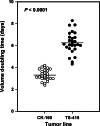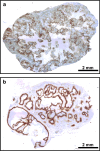Human cervical carcinoma xenograft models for studies of the physiological microenvironment of tumors
- PMID: 19214568
- PMCID: PMC12160152
- DOI: 10.1007/s00432-009-0558-8
Human cervical carcinoma xenograft models for studies of the physiological microenvironment of tumors
Abstract
Objective: To establish and characterize experimental tumor models of advanced squamous cell carcinoma of the uterine cervix.
Methods: Permanent cell lines (CK-160 and TS-415) were established from pelvic lymph node metastases of two cervical carcinoma patients. Xenografted tumors were initiated by inoculating 5 x 10(5) cells into the gastrocnemius muscle of BALB/c nu/nu mice. The tumors were characterized with respect to histological appearance, fraction of necrotic tissue (NF), pimonidazole hypoxic fraction (HF(Pim)), interstitial fluid pressure (IFP), extracellular pH (pH(e)), metastatic propensity, and radiation sensitivity.
Results: The xenografted tumors reflected the donor patients' tumors in histological appearance, metastatic propensity, and radiation sensitivity and showed significant intertumor heterogeneity in growth rate, NF, HF(Pim), IFP, and pH(e).
Conclusions: CK-160 and TS-415 xenografts possess properties making them relevant models for studies of the physiological microenvironment of cervical carcinoma and its influence on metastatic dissemination and response to treatment.
Figures





Similar articles
-
Microenvironment-associated lymph node metastasis of human cervical carcinoma xenografts.Acta Oncol. 2012 Apr;51(4):465-72. doi: 10.3109/0284186X.2011.636751. Epub 2012 Jan 31. Acta Oncol. 2012. PMID: 22292610
-
Prognostic relevance of low-grade versus high-grade FIGO IB1 squamous cell uterine cervical carcinomas.J Cancer Res Clin Oncol. 2019 Feb;145(2):457-462. doi: 10.1007/s00432-018-2793-3. Epub 2019 Jan 2. J Cancer Res Clin Oncol. 2019. PMID: 30603900 Free PMC article.
-
Establishment of a hepatocellular carcinoma cell line with unique metastatic characteristics through in vivo selection and screening for metastasis-related genes through cDNA microarray.J Cancer Res Clin Oncol. 2003 Jan;129(1):43-51. doi: 10.1007/s00432-002-0396-4. Epub 2002 Dec 4. J Cancer Res Clin Oncol. 2003. PMID: 12618900 Free PMC article.
-
Primary surgery versus primary radiotherapy with or without chemotherapy for early adenocarcinoma of the uterine cervix.Cochrane Database Syst Rev. 2013 Jan 31;2013(1):CD006248. doi: 10.1002/14651858.CD006248.pub3. Cochrane Database Syst Rev. 2013. PMID: 23440805 Free PMC article.
-
Sentinel node biopsy for lymph nodal staging of uterine cervix cancer: a systematic review and meta-analysis of the pertinent literature.Eur J Surg Oncol. 2015 Jan;41(1):1-20. doi: 10.1016/j.ejso.2014.09.010. Epub 2014 Oct 23. Eur J Surg Oncol. 2015. PMID: 25454828
Cited by
-
Three-dimensional bio-printing: A new frontier in oncology research.World J Clin Oncol. 2017 Feb 10;8(1):21-36. doi: 10.5306/wjco.v8.i1.21. World J Clin Oncol. 2017. PMID: 28246583 Free PMC article. Review.
-
The Microenvironment of Cervical Carcinoma Xenografts: Associations with Lymph Node Metastasis and Its Assessment by DCE-MRI.Transl Oncol. 2013 Oct 1;6(5):607-17. doi: 10.1593/tlo.13313. eCollection 2013. Transl Oncol. 2013. PMID: 24151541 Free PMC article.
-
Tumor radiomic heterogeneity: Multiparametric functional imaging to characterize variability and predict response following cervical cancer radiation therapy.J Magn Reson Imaging. 2018 May;47(5):1388-1396. doi: 10.1002/jmri.25874. Epub 2017 Oct 16. J Magn Reson Imaging. 2018. PMID: 29044908 Free PMC article.
-
Preclinical evaluation of Gd-DTPA and gadomelitol as contrast agents in DCE-MRI of cervical carcinoma interstitial fluid pressure.BMC Cancer. 2012 Nov 22;12:544. doi: 10.1186/1471-2407-12-544. BMC Cancer. 2012. PMID: 23173554 Free PMC article.
-
Hypoxia biomarkers in squamous cell carcinoma of the uterine cervix.BMC Cancer. 2015 Oct 26;15:805. doi: 10.1186/s12885-015-1828-2. BMC Cancer. 2015. PMID: 26502718 Free PMC article.
References
-
- Averette HE, Nguyen HN, Donato DM et al (1993) Radical hysterectomy for invasive cervical cancer: a 25-year prospective experience with the Miami technique. Cancer 71:1422–1437 - PubMed
-
- Fyles A, Milosevic M, Wong R et al (1998) Oxygenation predicts radiation response and survival in patients with cervix cancer. Radiother Oncol 48:149–156. doi:10.1016/S0167-8140(98)00044-9 - PubMed
-
- Fyles A, Milosevic M, Pintilie M et al (2006) Long-term performance of interstitial fluid pressure and hypoxia as prognostic factors in cervix cancer. Radiother Oncol 80:132–137. doi:10.1016/j.radonc.2006.07.014 - PubMed
-
- Gulliksrud K, Brurberg K, Rofstad EK (2008) Dynamic contrast-enhanced magnetic resonance imaging of tumor interstitial fluid pressure. Radiother Oncol [Epub ahead of print]. doi:10.1016/j.radonc.2008.08.015 - PubMed
-
- Hall EJ, Giaccia AJ (2006) Radiobiology for the radiologist, chapter 6. Williams & Wilkins, Philadelphia
Publication types
MeSH terms
LinkOut - more resources
Full Text Sources
Medical
Research Materials
Miscellaneous

